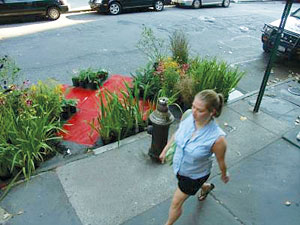Radical Idea: No Park
progressive utilization of rarely inhabited fire hydrant spaces


As the population grows and automobiles continue to be a primary mode of transportation, we are forced to come up with more inventive solutions for our green spaces as well as more nuanced approaches to reducing the impact. Recently Natalie Jeremijenko, associate professor of visual art at NYU, spoke at UWEC’s Forum Series and explained how she and a handful of teachers, artists, and inventor-activists are finding ways to re-imagine the world in a sustainable way.
One of the ingenious solutions is called a No Park. Think of a rain garden – a plot of space designed to catch stormwater runoff from roofs and roads. Now take that idea and superimpose it on an emergency parking space, usually next to a fire hydrant. The logic is that the spaces are only used in emergencies and are otherwise dead zones – a waste of pavement, if you will. By taking those rarely used spaces and inhabiting them with low growth mosses and grasses, any adjacent runoff is captured and filtered, retaining moisture for nearby trees while stabilizing the soil instead of letting the oily, contaminated water run straight into the sewers and water supply. In the rare event of an emergency, responder vehicles can still pull into the space as needed. Once the emergency is over, the temporarily flattened plants slowly raise back up and continue to provide a green oasis for pedestrians and bicyclists. BONUS: It can also be thought of as a community interaction space!
| Driving How We Get Around « PREV | NEXT » 10 Cities with "Street Environments" Worth Striving for |


















